
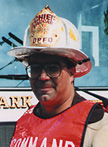
BY BOB VACCARO
The Holtsville (NY) Fire Department has been around since 1929 as part of a joint fire department with a neighboring town.
It decided in 1972 to split off and start its own separate independent fire district. Since that time, it has always been proactive in its choice of fire apparatus throughout its 48 years of existence.
The fire department’s response district is like most in the area: It has a hotel, several schools, strip shopping centers, a light industrial area, apartments, condominiums, and numerous single-family dwellings.
The department has tried several manufacturers through the years, but for this purchase it went back to a familiar brand that gave great service. According to First Assistant Chief Doug Costello, “It was on my plate to design new apparatus for our fire district after spending the past two years planning for this new purchase with our apparatus committee that consisted of ex chiefs, MPOs, and officers. We didn’t really have an apparatus replacement program like other departments; our decision was based on usage and maintenance issues. Since we had several pumpers that were more than 20 years old, it was time for two new pumpers.”

1 The Holtsville Fire Department’s twin E-ONE Typhoon pumpers. (Photos by author.)
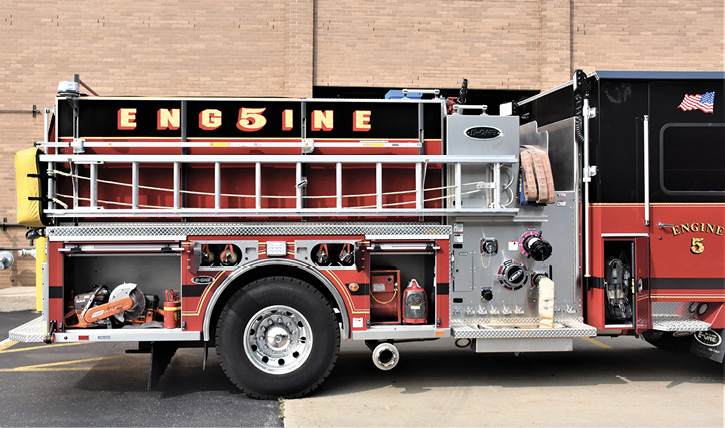
2 Officer-side compartments containing a portable generator, a fan, spare self-contained breathing apparatus (SCBA) cylinders, and saws.
| Specifications E-ONE Typhoon X extended cabs and bodies 12-foot extended cab heights All stainless-steel cabs and bodies Cummins 450-hp ISL9 engines Allison EVS 3000 transmissions Qmax 1,500-gpm single-stage pumps 780-gallon polypropylene tanks |
“This time around, we wanted to go with a single-source manufacturer and keep both vehicles identical to make maintenance and training on the same level. Cost is also always a factor in any purchase we make as well. The committee looked at several manufacturers during the prepurchase phase,” Costello continues. “We looked at our previous purchases for all types of different apparatus that we had operated over the past 20 years, and after several presentations, E- ONE came out on top. They really gave an impressive presentation with great prices as well. Plus, we had a 1995 E- ONE pumper that gave us great service and was easy to operate. Our firefighters were familiar with the brand, so the choice blended well with our fire district.”
“During this time, we decided to downsize our apparatus fleet, which will save us money in the long run. Besides the two engines we decided to replace, a third engine was a pumper that we really didn’t use that much anymore, and it was starting to give us some problems. Also, for this build we went with the HGAC program. It made life a great deal easier for this purchase since we could pick a manufacturer that we really wanted instead of having to go out to bid,” Costello adds.
“Since we bought twin pumpers at the same time, they are set up identical for our operations. They both have identical equipment, which is basic engine company tools, nozzles and fittings, some forcible entry tools, battery-powered TNT rescue tools, and a low hosebed with identical hose loads. Our idea is to swap them back and forth first and second due either weekly or monthly to prevent excess wear and tear on the chassis and overall operation of the two units,” Costello says. “The design we chose proved to be really practical. We have simple pump panels; the operation is simple; and the vehicles have great turning radii, which will prove to be effective to operate in some of the tight streets we have in our response district.”
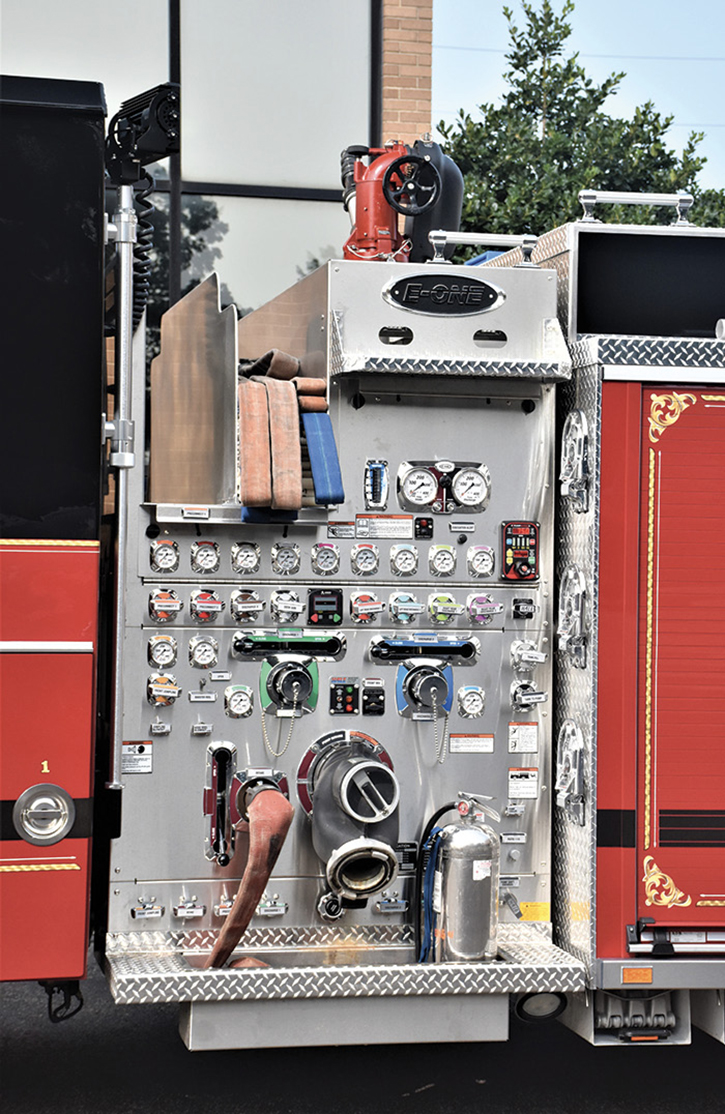
3 The pumpers feature simple pump panels with deluge guns above.

4 The driver’s side with 2½-inch roll-ups, fittings, a 50-foot section of five-inch hose, an SCBA for the driver, and spare SCBA cylinders.
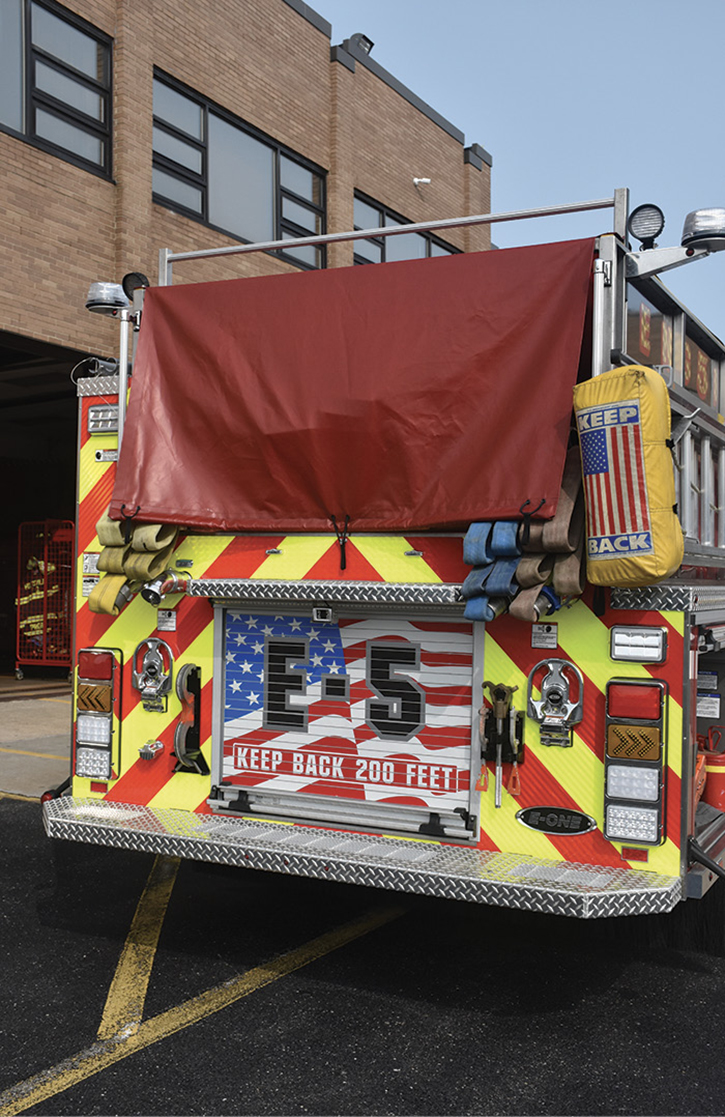
5 The low rear hosebed. The rear compartment holds a battery-powered TNT tool
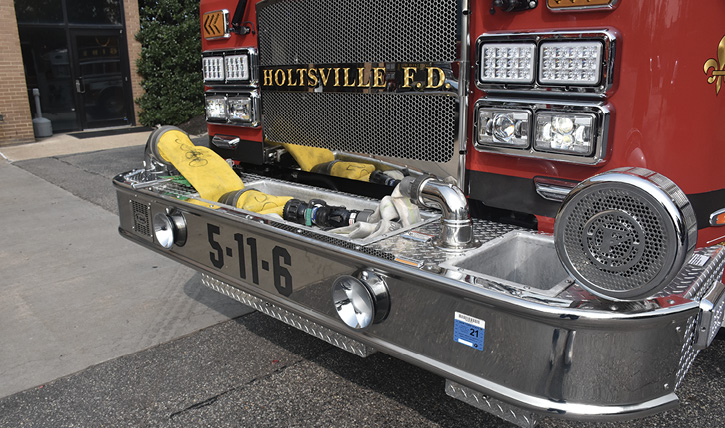
6 The extended front bumper with five-inch LDH hydrant hookup and 1¾-inch trash line.
| Department Response District: 7.1 square miles; population 19,700 Alarms answered in 2019: 1,104 3 engines 1 truck 1 heavy rescue 1 storm EVAC truck 2 ambulances |
The hosebed configurations are as follows: Off the rear are 200 feet of preconnected 2½-inch attack line with 200 feet of 2½-inch dead lay to extend it, 300 feet of 3-inch supply line, 1,000 feet of 5-inch large-diameter hose (LDH) supply line, and two 200-foot 1¾-inch preconnect attack lines with 100 feet of 1¾-inch dead lay to extend. Crosslays behind cab are two 200 feet of 2½-inch reduced to 300 feet of 1¾-inch attack line. The front bumper has 100 feet of 1¾-inch attack line and 25 feet of 5-inch front suction supply line.
“We also decided not to have a foam tank,” Costello adds. “Our firefighters will use external foam eductors, which make it easier, and we don’t have to worry about flushing out the tank and lines.”
The Holtsville Fire Department planned well for this purchase. The truck committee looked at all options before deciding on one manufacturer to build the two engines. Past performance as well as cost were deciding factors. The department wanted a simple, functional design that would work well in the response district. It designed low hosebeds so firefighters would have an easier time stretching hoselines safely, more maneuverability responding through the district, and ample compartment space to carry all the necessary tools now and into the future. Overall, because of smart planning, the department has taken delivery of two pumpers that will last well into the future.
BOB VACCARO has more than 40 years of fire service experience. He is a former chief of the Deer Park (NY) Fire Department. Vaccaro has also worked for the Insurance Services Office, the New York Fire Patrol, and several major commercial insurance companies as a senior loss-control consultant. He is a life member of the IAFC.

